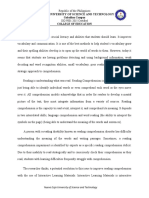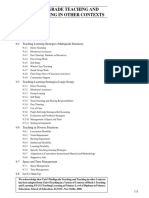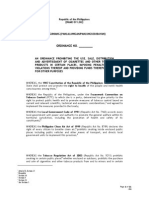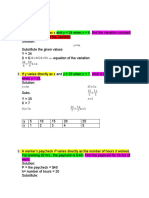0 ratings0% found this document useful (0 votes)
137 viewsContent and Approaches
Content and Approaches
Uploaded by
Reah Jane Grengia1) Creating motivation for reading, reading aloud excitingly, creating a reading space, letting children choose books, and setting aside daily reading time can help develop a love of reading in children.
2) Children's literature enhances language skills and critical thinking, and can be used for thoughtful discussion, building a reading community, developing curiosity and imagination, and learning about the world.
3) Sharing stories aloud for 10 minutes a day, being prepared, getting comfortable, using different tones and props, and making it interactive can help create lifelong readers.
Copyright:
© All Rights Reserved
Available Formats
Download as PPTX, PDF, TXT or read online from Scribd
Content and Approaches
Content and Approaches
Uploaded by
Reah Jane Grengia0 ratings0% found this document useful (0 votes)
137 views6 pages1) Creating motivation for reading, reading aloud excitingly, creating a reading space, letting children choose books, and setting aside daily reading time can help develop a love of reading in children.
2) Children's literature enhances language skills and critical thinking, and can be used for thoughtful discussion, building a reading community, developing curiosity and imagination, and learning about the world.
3) Sharing stories aloud for 10 minutes a day, being prepared, getting comfortable, using different tones and props, and making it interactive can help create lifelong readers.
Original Title
Presentation
Copyright
© © All Rights Reserved
Available Formats
PPTX, PDF, TXT or read online from Scribd
Share this document
Did you find this document useful?
Is this content inappropriate?
1) Creating motivation for reading, reading aloud excitingly, creating a reading space, letting children choose books, and setting aside daily reading time can help develop a love of reading in children.
2) Children's literature enhances language skills and critical thinking, and can be used for thoughtful discussion, building a reading community, developing curiosity and imagination, and learning about the world.
3) Sharing stories aloud for 10 minutes a day, being prepared, getting comfortable, using different tones and props, and making it interactive can help create lifelong readers.
Copyright:
© All Rights Reserved
Available Formats
Download as PPTX, PDF, TXT or read online from Scribd
Download as pptx, pdf, or txt
0 ratings0% found this document useful (0 votes)
137 views6 pagesContent and Approaches
Content and Approaches
Uploaded by
Reah Jane Grengia1) Creating motivation for reading, reading aloud excitingly, creating a reading space, letting children choose books, and setting aside daily reading time can help develop a love of reading in children.
2) Children's literature enhances language skills and critical thinking, and can be used for thoughtful discussion, building a reading community, developing curiosity and imagination, and learning about the world.
3) Sharing stories aloud for 10 minutes a day, being prepared, getting comfortable, using different tones and props, and making it interactive can help create lifelong readers.
Copyright:
© All Rights Reserved
Available Formats
Download as PPTX, PDF, TXT or read online from Scribd
Download as pptx, pdf, or txt
You are on page 1of 6
Content and Approaches
Developing Love for Reading
A love for reading can be hugely valuable for children. The benefits of
leisure reading include increased general knowledge, a positive impact on
academic achievement, enhanced reading ability and vocabulary growth.
There are a few key things you can do to help your kid/s to develop love for
reading and become a lifelong reader:
• Create Motivation • Talk about books
• Read aloud (and make it exciting) • Read to them
• Create a space for reading • Set aside time daily for your kids to read
• Let children choose books • Read
Role of Children's Literature in Developing
Love for Reading
Children's literature is important since it enhances development of language skills
and other critical thinking skills that provide the foundation of learning.
1. Children's Literature as a Space for Thoughtful Discussion.
2. Children's Literature as a Catalyst for Building a Community of Readers.
3. Children's Literature as a Vicarious Experience.
4. Children's Literature for Developing Curiosity and Imagination.
5. Children's Literature as Example of Language Play.
6. Children's Literature for Developing Narrative Competencies.
7. Children's Literature as Mentor Texts for Writing.
8. Children's Literature for Developing a Sense of Being a Reader.
9. Children's Literature as a Way of Coming to Know the World.
10. Children's Literature as a Way of Developing Reading Abilities
Ways of Sharing Stories to Young Readers
Sharing stories aloud is a fantastically fun way to celebrate the joys of books and
spark young imaginations and reading together for just ten minutes a day can help
create readers for life. Here are the World Book Day team's tips on how to make
those moments magical.
Ten tips on how to share stories with children:
1. Be prepared 6. Vary the tone
2. Get comfy 7. Add movement and props
3. Holding the book 8. Make it interactive
4. Get into character 9. Discuss as you read
5. Mix it up 10. Take it to a new level
Development of Book and Print Orientation
Skills
Book awareness includes concepts such as front cover, back cover, title, author,
and which way to turn the pages. It even incorporates how we treat books. In my
home, I say, “Books are not toys.
Print awareness is one of five critical pre-reading skills. Without print awareness,
children are unable to develop other literacy skills such as reading, spelling, and
handwriting.
A child’s print awareness develops when those close to him point out letters and
words in text found in the child’s environment. It also develops through playing
word games, when you turn the pages of a book, and when you run your finger
under a line of text as you read.
You might also like
- Fernanado Habegger - Mastering Small Stakes Pot-Limit Omaha-D&B Publishing (2020)Document352 pagesFernanado Habegger - Mastering Small Stakes Pot-Limit Omaha-D&B Publishing (2020)yaou.wu100% (1)
- Nursing Research Sara Jo Brown Edition Comparison 3 Edition Versus 4th EditionDocument3 pagesNursing Research Sara Jo Brown Edition Comparison 3 Edition Versus 4th Editionynottrip0% (1)
- Summer Internship Final Presentation (Ajay Kumar Meena)Document31 pagesSummer Internship Final Presentation (Ajay Kumar Meena)Ajay kumar meena100% (1)
- Module 2 ElectiveDocument24 pagesModule 2 ElectiveArleen TalamayanNo ratings yet
- Local LiteratureDocument5 pagesLocal LiteratureClaire LagartoNo ratings yet
- Demonstration Lesson Plan For Multigrade ClassesDocument9 pagesDemonstration Lesson Plan For Multigrade ClassesIrish Cheska EspinosaNo ratings yet
- Multi Grade ClassDocument4 pagesMulti Grade ClassPems SolaimanNo ratings yet
- Film Analysis Cum Reflection of The Films "Mga Munting Tinig" and "Dead Poet Society"Document8 pagesFilm Analysis Cum Reflection of The Films "Mga Munting Tinig" and "Dead Poet Society"Meynard LeonipaNo ratings yet
- Ece10 Daisy O. PatanaoDocument5 pagesEce10 Daisy O. PatanaoJalthia MirandaNo ratings yet
- 04 MTBDocument42 pages04 MTBRooby StephanieNo ratings yet
- Professional Portfolio Reflection Edu 1010Document10 pagesProfessional Portfolio Reflection Edu 1010api-243252060No ratings yet
- E309 Multigrade Classes ReportDocument23 pagesE309 Multigrade Classes Reportshyvette.grefaldaNo ratings yet
- Science34 Q1 W6 Milyn AlipioDocument19 pagesScience34 Q1 W6 Milyn AlipioCHERRY MAE ALVARICONo ratings yet
- MTB Mle LiteracyDocument4 pagesMTB Mle Literacyror Wie100% (1)
- Myra O. Anquilo Beed 3A Activity:1 compare your definition with what you have just read about multi-grade. how was your definition similar or different? 》Document3 pagesMyra O. Anquilo Beed 3A Activity:1 compare your definition with what you have just read about multi-grade. how was your definition similar or different? 》Jhay DE ASISNo ratings yet
- Action Research MadronioDocument18 pagesAction Research MadronioVeronica Vegiga BarbosaNo ratings yet
- Ged 105 Technology For Teaching Elementary GradesDocument3 pagesGed 105 Technology For Teaching Elementary GradesJean Aireen Bonalos Espra100% (2)
- LP in Compound Words English 5Document7 pagesLP in Compound Words English 5Aleza PearlNo ratings yet
- Lesson 2 Recalling Experiences: Type of Stories Why You Liked? Why You Disliked? Animal StoriesDocument6 pagesLesson 2 Recalling Experiences: Type of Stories Why You Liked? Why You Disliked? Animal StoriesMaricel Viloria100% (1)
- q1 Epp 4 PPT Week 3Document49 pagesq1 Epp 4 PPT Week 3Crizel GonzalesNo ratings yet
- Adetailedlessonplaninenglish3 150122194739 Conversion Gate02Document5 pagesAdetailedlessonplaninenglish3 150122194739 Conversion Gate02Cathy Biasa100% (2)
- Summary Report Review of The Current Situation and Practices of PHL Multigrade Schools CompDocument59 pagesSummary Report Review of The Current Situation and Practices of PHL Multigrade Schools CompRalph Eric C. Mangalawan100% (1)
- LE Language Q1 Week3 v.2Document16 pagesLE Language Q1 Week3 v.2Reena Leah MetinNo ratings yet
- Teacher As A Facilitator - NoteDocument2 pagesTeacher As A Facilitator - NoteYasar MoideenNo ratings yet
- FS2 Chapter 1 Exploring The CurriculumDocument37 pagesFS2 Chapter 1 Exploring The CurriculumKarah Shayne MarcosNo ratings yet
- Multigrade Teaching ApproachDocument19 pagesMultigrade Teaching ApproachUma SinghNo ratings yet
- 5e Lesson Plan Erosion WstokleyDocument4 pages5e Lesson Plan Erosion Wstokleyapi-4805117500% (1)
- Lesson #2 The TeacherDocument6 pagesLesson #2 The TeacherZhayna CaleonNo ratings yet
- Activity 3a Tiered AssignmentsDocument5 pagesActivity 3a Tiered AssignmentsSiti Zaiton BaserahNo ratings yet
- Activity 1 (Volleyball) - AlfaroDocument3 pagesActivity 1 (Volleyball) - AlfaroEster M. DunggonNo ratings yet
- Factors and Conditions Giving Rise To Multigrade Classes: Lesson 2Document3 pagesFactors and Conditions Giving Rise To Multigrade Classes: Lesson 2Hagiar NasserNo ratings yet
- School Grade Teacher Jevy Rose D. Paz Subject Date Grading Time Instructor Teodora Mangilaya I. ObjectivesDocument7 pagesSchool Grade Teacher Jevy Rose D. Paz Subject Date Grading Time Instructor Teodora Mangilaya I. ObjectivesJevy Rose Dimalaluan PazNo ratings yet
- A Detailed Lesson PlanDocument8 pagesA Detailed Lesson PlanLeizan SampiaoNo ratings yet
- Assessment Plan TimelineDocument3 pagesAssessment Plan Timelineapi-451438382No ratings yet
- Chapter 5 PracticalityDocument2 pagesChapter 5 PracticalityZarah Joyce Segovia100% (1)
- The School Head in School-Based Management (SBM)Document15 pagesThe School Head in School-Based Management (SBM)Lara MendozaNo ratings yet
- Questioning PDFDocument7 pagesQuestioning PDFLokesh NANo ratings yet
- Action Research On Effectiveness of Marungko Approach To Grades V and Vi Non-Readers of Olingan Elementary SchoolDocument15 pagesAction Research On Effectiveness of Marungko Approach To Grades V and Vi Non-Readers of Olingan Elementary SchoolMary Ann YanoNo ratings yet
- Ed 52 - Multi-Grade Teaching The MentorsDocument5 pagesEd 52 - Multi-Grade Teaching The Mentorsapi-550734106No ratings yet
- MC Engl 101 Act 3Document4 pagesMC Engl 101 Act 3Jervyn GuiananNo ratings yet
- Developing Activity PlanDocument9 pagesDeveloping Activity PlanKen GorresNo ratings yet
- Multigrade Lesson PlanDocument31 pagesMultigrade Lesson PlanKim BantaoNo ratings yet
- HOTS IT-based ProjectsDocument14 pagesHOTS IT-based ProjectsmarygracejaspesiarotNo ratings yet
- Classroom Managment JournalDocument4 pagesClassroom Managment Journalapi-489871389No ratings yet
- Esson 1: Physical EnvironmentDocument1 pageEsson 1: Physical EnvironmentXxxxxNo ratings yet
- English Day 2Document6 pagesEnglish Day 2joannNo ratings yet
- LESSON 4 - ExploreDocument2 pagesLESSON 4 - ExploreDora ShaneNo ratings yet
- DLP L02 - Multiple IntelligenceDocument3 pagesDLP L02 - Multiple IntelligenceJeckriz MondragonNo ratings yet
- Field Study 1.6: Classroom Management and Classroom RoutinesDocument8 pagesField Study 1.6: Classroom Management and Classroom RoutinesAngelu Dalida SanchezNo ratings yet
- English 3 TG Quarter 4 PDFDocument101 pagesEnglish 3 TG Quarter 4 PDFJosieNo ratings yet
- Lesson 6Document3 pagesLesson 6Jonah SalcedoNo ratings yet
- A Semi Detailed Lesson Plan in Science IIIDocument2 pagesA Semi Detailed Lesson Plan in Science IIIAnonymous IlLdYBJn4No ratings yet
- A Detailed Lesson Plan in ArtsDocument8 pagesA Detailed Lesson Plan in ArtsRhiane StanfordNo ratings yet
- School Aesthetics and Its ImpactsDocument10 pagesSchool Aesthetics and Its Impactsapi-661550730No ratings yet
- BW - Arts 3Document6 pagesBW - Arts 3KARENNo ratings yet
- Teaching Multi-Grade Classroom Lesson PlanDocument16 pagesTeaching Multi-Grade Classroom Lesson PlanElijah Riley MontefealcoNo ratings yet
- The History of Philippine Education System Lecture No. 4Document46 pagesThe History of Philippine Education System Lecture No. 4Abigail PanesNo ratings yet
- Grimaldo, Krizza F. - (9 & 10 Reporter) Self Check and Self ReflectionDocument6 pagesGrimaldo, Krizza F. - (9 & 10 Reporter) Self Check and Self ReflectionGRIMALDO, Krizza F.No ratings yet
- Classroom Gadgets: Using Technology To Enhance LearningDocument2 pagesClassroom Gadgets: Using Technology To Enhance LearningGie Marie Francisco UmaliNo ratings yet
- Assure Model Lesson Plan Lydia DunlevyDocument4 pagesAssure Model Lesson Plan Lydia Dunlevyapi-299916070No ratings yet
- Educating Learners With Visual Impairment In ZambiaFrom EverandEducating Learners With Visual Impairment In ZambiaRating: 5 out of 5 stars5/5 (1)
- Through the Looking-Glass, and What Alice Found There: Unabridged with the Original Illustrations by John TennielFrom EverandThrough the Looking-Glass, and What Alice Found There: Unabridged with the Original Illustrations by John TennielNo ratings yet
- Mathematics10 Quarter1 Module3 Week3Document6 pagesMathematics10 Quarter1 Module3 Week3Karu GreyNo ratings yet
- Model Template Anti Tobacco Ordinance For Lgus PDFDocument11 pagesModel Template Anti Tobacco Ordinance For Lgus PDFAko Si BemNo ratings yet
- Indian Standard: Specification For Steel Windows For Industrial BuildingsDocument22 pagesIndian Standard: Specification For Steel Windows For Industrial BuildingsSiriveri Lakshmi KanthNo ratings yet
- MCQs Legal Aspects of BusinessDocument11 pagesMCQs Legal Aspects of BusinessAshish Vyas100% (1)
- Heart Grade 10Document18 pagesHeart Grade 10amulyajadhav119No ratings yet
- Salsa RojaDocument2 pagesSalsa RojajanetNo ratings yet
- MA2451-Engineering Economics and Cost Analysis-1 QBDocument8 pagesMA2451-Engineering Economics and Cost Analysis-1 QBPrasanna Sekar0% (1)
- Robinson, Julia Bowman PDFDocument4 pagesRobinson, Julia Bowman PDFcreeshaNo ratings yet
- IOSH MS Module 2 Workbook v4.0 PDFDocument37 pagesIOSH MS Module 2 Workbook v4.0 PDFDaria D'souzaNo ratings yet
- Project Report (Taywade)Document10 pagesProject Report (Taywade)ImtiyazAli SiddiqueNo ratings yet
- LearnEnglish You Re Hired Episode 10Document4 pagesLearnEnglish You Re Hired Episode 10Sondes TrabelsiNo ratings yet
- Pepper FryDocument13 pagesPepper FryMukesh KumarNo ratings yet
- Interview QuestionsDocument2 pagesInterview QuestionsBenedict MarzanNo ratings yet
- Housing Module 1Document16 pagesHousing Module 1Kyla TiangcoNo ratings yet
- Trust Me, I'm Your Private Banker: Financial ServicesDocument12 pagesTrust Me, I'm Your Private Banker: Financial ServiceskaiuskNo ratings yet
- Is 11656 1986 PDFDocument22 pagesIs 11656 1986 PDFSiddharth GuptaNo ratings yet
- S7 Service 1 Course (ST-SERV1) : Short DescriptionDocument2 pagesS7 Service 1 Course (ST-SERV1) : Short DescriptionIndustrial ItNo ratings yet
- LACPDocument26 pagesLACPGilfer VasquezNo ratings yet
- RVfpga Slides 8 5x14Document116 pagesRVfpga Slides 8 5x14Soumya Ranjan MishraNo ratings yet
- Iec 61869 1 2007 10Document134 pagesIec 61869 1 2007 10Alejandro García Carlen86% (7)
- VariationsDocument7 pagesVariationsAngelica F. BienesNo ratings yet
- Bangladesh Studies Assignment - 2Document8 pagesBangladesh Studies Assignment - 2Rownak Jahan SraboniNo ratings yet
- Advanced 3D Printing Klipper Kit Installation Guide v1.1Document17 pagesAdvanced 3D Printing Klipper Kit Installation Guide v1.1Ezequiel bonmati gonzalezNo ratings yet
- House Beautiful PenickDocument16 pagesHouse Beautiful PenickMirela DuculescuNo ratings yet
- Actualizar Firmware MypbxstandarDocument7 pagesActualizar Firmware Mypbxstandarnexuscorp09No ratings yet
- Fundamental Concepts of PharmacologyDocument21 pagesFundamental Concepts of PharmacologyYean Delos ReyesNo ratings yet
- Computer JSS 1 First - ThirdDocument117 pagesComputer JSS 1 First - ThirdJames80% (5)

























































































